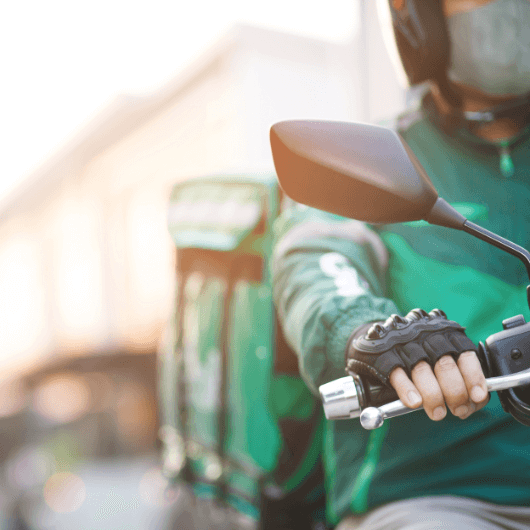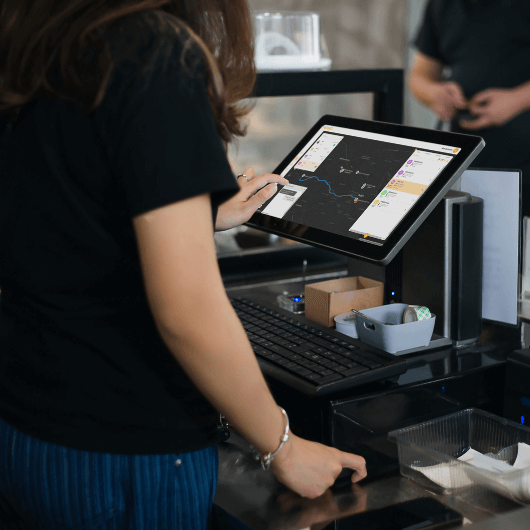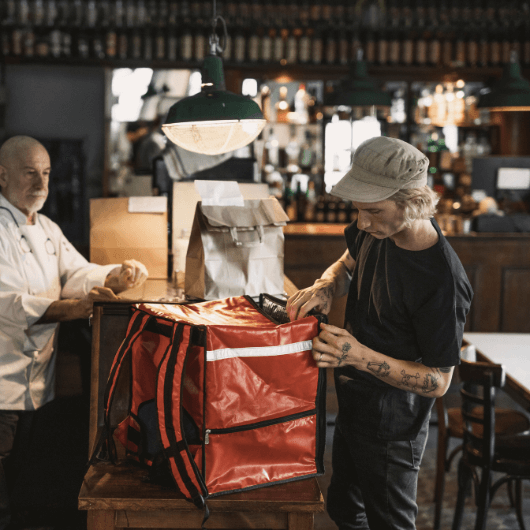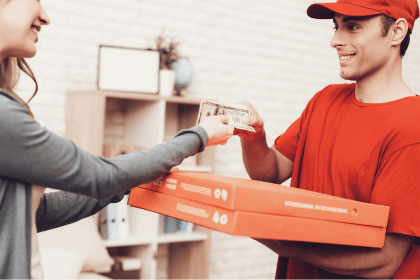
How to make restaurant food delivery profitable
January 4, 2023
Discover the essential tips and strategies for selecting the perfect delivery fleet for your restaurant. Maximize efficiency, customer satisfaction, and profitability with our expert guidance on restaurant delivery logistics.
There are many decisions you have to make as a restaurant business owner: the location of your restaurant, how to design your interior, developing your menu, and how you’ll go about hiring your staff.
And it doesn’t stop here! One decision restaurant owners now must make: which delivery service is best for restaurants?
The demand for food delivery has spiked in recent years, and now online ordering accounts for about 40% of total restaurant sales. Although this sector has had its fair share of growing pains, it has certainly helped businesses maximize profits, and it can be a key factor in becoming a successful restaurant.
There are a ton of delivery service providers for restaurants to choose from, and there is not necessarily one overall best choice.
It often depends on the restaurant’s business model, locations, size, volume of orders, and the availability of delivery drivers in the area.
Here is how restaurant owners and managers can select the best delivery provider for their restaurants:
Before starting your research on different delivery options, it can be helpful to understand what exactly your restaurant needs. You’ll want to put together a solid delivery strategy by defining your business goals and looking at food delivery trends, delivery volume, expectations, and budget.
For example, a ghost kitchen (also known as a dark kitchen) will have an incredibly high demand for online orders and depend on third-party delivery platforms to be a profitable, successful business. On the other hand, a single-location brunch spot open for half the week may only complete a few dozen online orders and simply have the goal of increasing its online presence to new customers. Each business will likely choose a different delivery platform.
Certain third-party platforms may be better depending on your restaurant’s size, location, order volume, budget, and menu offerings. The component that will likely be a deciding factor for restaurants is the delivery fee. Many restaurants operate on razor-thin margins, so often, the lower the fees, the better.
Depending on your location, consumers may use one restaurant delivery service more often than others. Or, they may use multiple. It may be in your restaurant’s best interest to use multiple online ordering platforms to ensure you’re reaching the greatest delivery range possible.
The top food delivery apps have the greatest geographical reach and customer demand. For this reason, they may be the best place to start researching for your restaurant. Here are some of the top delivery platforms to consider:
Uber Eats is a global delivery giant that is the most widely available food delivery service in six continents.
Pros: extensive market share covering a vast geographical area, user-friendly mobile app, and robust tracking system for deliveries.
Cons: high delivery commissions, level of competition for customer attention, longer delivery times during peak hours.
Fees: charges restaurants a commission fee on each order depending on the selected business plan and locations, ranging from 15-30% per order. Often charges a sign-up fee (sometimes it is waived).
For more on our partnership with them, check out our recent webinar: Making delivery effortless for restaurants.
GrubHub is another major player in the food delivery industry, with a strong presence in various regions.
Pros: established user base, it operates in a variety of cities and suburbs, and offers marketing tools to help restaurants attract potential customers.
Cons: charges fees that can cut into profits, stiff competition from other restaurants on the platform, and delivery experience may vary depending on the delivery driver.
Fees: depending on if a restaurant chooses to be a sponsored listing on the app, delivery fees are calculated based on this as well as location, ranging from 10-30% per order.

DoorDash is known for its delivery efficiency and they are often the consumer preference (what with them being the leader in online food delivery in the U.S.)!
Pros: fast delivery times, wide network in small and large cities, customer loyalty encouraged via the DashPass subscription.
Cons: restaurants may find the commission fees substantial, driver availability can be challenging in certain areas, and they have faced controversies regarding worker pay and restaurant fees.
Fees: depends on agreement, can range from 10-30%
These are just a few delivery service providers your restaurant can choose from! There are many more region-specific options, like Deliveroo (UK+), iFood (Brazil), Rappi (Central and South America), Zomato (India), and Takeaway (Western Europe).
Now that you have a brief overview of some of the most popular third-party delivery services, here are some tips for how you can evaluate which is best for your restaurant.
Creating an in-house delivery team offers several distinct advantages for restaurants.
First, it provides greater control over the entire delivery process, from the order to the drop-off to the customer.
This control can lead to improved consistency in food quality and delivery times, which can greatly improve the customer delivery experience and reduce last-mile delivery problems.

It also means you retain a larger share of the revenue since there are no third-party commission fees.
Lastly, you have the flexibility to tailor delivery operations to your specific needs and branding, allowing for a seamless extension of your restaurant’s identity beyond the traditional restaurant dining experience.
Managing and training an in-house delivery team comes with its share of challenges and responsibilities. Particularly today when there is a shortage of delivery drivers. Investing, hiring, training, and retaining reliable delivery drivers can be time-consuming and costly.
Finding drivers can be difficult, as well as maintaining drivers over time. If you own a fleet of delivery vehicles, this will require ongoing maintenance and expense.
You’ll also need to handle delivery logistics, including delivery route planning and dispatching efficiently to meet customer expectations for delivery times.

Some restaurants opt for a combination of third-party apps and in-house delivery to reap the benefits of both choices while mitigating disadvantages.
This approach allows restaurants to tap into the broader customer base of third-party platforms while maintaining control over certain aspects of the delivery process.
For example, you can use third-party services for reaching new customers and handling high-demand periods, while relying on your in-house team for local deliveries within the self-delivery sweet spot or areas where you have a strong presence.
With two forms of delivery, this adds another level of complexity – now you have two channels to manage.
While this may sound like too much to handle, delivery management software can help you streamline this by essentially putting delivery on autopilot, regardless of what online ordering system or combination of fleets you choose to use!
Choosing the most suitable delivery service for your restaurant is a pivotal decision in today’s dynamic food industry landscape.
As the food delivery sector continues to grow, the choice between using third-party platforms, in-house delivery teams, or a hybrid approach requires the right business strategy.
While there is not an exact answer to, “Which delivery service is best for restaurants?”, you can understand your restaurant’s specific needs and begin evaluating the pros, cons, and fees of each option.
By making a well-informed choice, you can enhance your restaurant’s delivery sales, online presence, customer satisfaction, and overall success in the ever-evolving world of food delivery.

Hybrid delivery is the best of both worlds when it comes to setting up your food delivery business for your restaurant.
Want to learn how to do this?
Download our eBook on how to take a self-delivery approach to hybrid delivery without hiring more drivers!
Deliver more for your customers with reliable food delivery management software that automates dispatch, improves customer experience and increases profitability with ease.

January 4, 2023

May 1, 2023

September 7, 2023